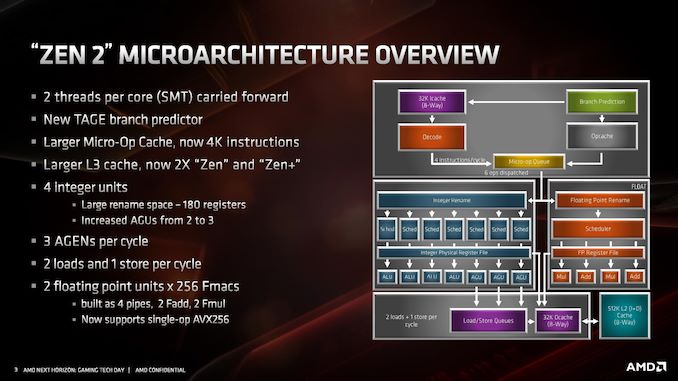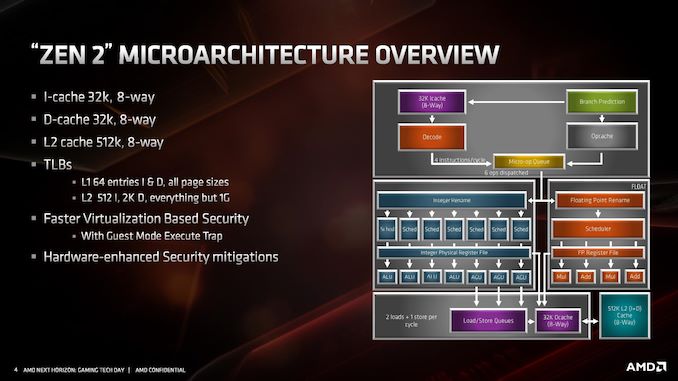AMD Zen 2 Microarchitecture Analysis: Ryzen 3000 and EPYC Rome
by Dr. Ian Cutress on June 10, 2019 7:22 PM EST- Posted in
- CPUs
- AMD
- Ryzen
- EPYC
- Infinity Fabric
- PCIe 4.0
- Zen 2
- Rome
- Ryzen 3000
- Ryzen 3rd Gen
AMD Zen 2 Microarchitecture Overview
The Quick Analysis
At AMD’s Tech Day, on hand was Fellow and Chief Architect Mike Clark to go through the changes. Mike is a great engineer to talk to, although what always amuses me (for any company, not just AMD) is that engineers that talk about the latest products coming to market are already working one, two, or three generations ahead at the company. Mike remarked that it took him a while to think back to the specific Zen+ to Zen 2 changes, while his mind internally is already several generations down the line.
An interesting element to Zen 2 is around the intention. Initially Zen 2 was merely going to be a die shrink of Zen+, going from 12nm down to 7nm, similar to what we used to see with Intel in its tick-tock model for the initial part of the century. However, based on internal analysis and the time frame for 7nm, it was decided that Zen 2 would be used as a platform for better performance, taking advantage of 7nm in multiple ways rather than just redesigning the same layout on a new process node. As a result of the adjustments, AMD is promoting a +15% IPC improvement for Zen 2 over Zen+.
When it comes down to the exact changes in the microarchitecture, what we’re fundamentally looking at is still a similar floorplan to what Zen looks like. Zen 2 is a family member of the Zen family, and not a complete redesign or different paradigm on how to process x86 – as will other architectures that have familial updates, Zen 2 affords a more efficient core and a wider core, allowing better instruction throughput.
At a high level, the core looks very much the same. Highlights of the Zen 2 design include a different L2 branch predictor known as a TAGE predictor, a doubling of the micro-op cache, a doubling of the L3 cache, an increase in integer resources, an increase in load/store resources, and support for single-operation AVX-256 (or AVX2). AMD has stated that there is no frequency penalty for AVX2, based on its energy aware frequency platform.
AMD has also made adjustments to the cache system, the most notable being for the L1 instruction cache, which has been halved to 32 kB, but associativity has doubled. This change was made for important reasons, which we’ll go into over the next pages. The L1 data cache and L2 caches are unchanged, however the translation lookaside buffers (TLBs) have increased support. AMD also states that it has added deeper virtualization support with respect to security, helping enable features further down the pipeline. As mentioned previously in this article, there are also security hardening updates.
For the quick analysis, it’s easy to tell that doubling the micro-op cache is going to offer a significant improvement to IPC in a number of scenarios, and combine that with an increase in load/store resources is going to help more instructions get pushed through. The double L3 cache is going to help in specific workloads, as would the AVX2 single-op support, but the improved branch predictor is also going to showcase raw performance uplift. All-in-all, for an on-paper analysis, AMD’s +15% IPC improvement seems like a very reasonable number to promote.
Over the next few pages, we’ll go deeper into how the microarchitecture has changed.












216 Comments
View All Comments
Thunder 57 - Sunday, June 16, 2019 - link
It appears they traded half the L1 instruction cache to double the uop cache. They doubled the associativity to keep the same hit rate but it will hold fewer instructions. However, the micro-op cache holds already decoded instructions and if there is a hit there it saves a few stages in the pipeline for decoding, which saves power and increases performance.phoenix_rizzen - Tuesday, June 11, 2019 - link
From the article:"Zen 2 will offer greater than a >1.25x performance gain at the same power,"
I don't think that means what you meant. :) 1.25x gain would be 225% or over 2x the performance. I think you meant either:
"Zen 2 will offer greater than a 25% performance gain at the same power,"
or maybe:
"Zen 2 will offer greater than 125% performance at the same power,"
or possibly:
"Zen 2 will offer greater than 1.25x performance at the same power,"
phoenix_rizzen - Tuesday, June 11, 2019 - link
From the article:"With Matisse staying in the AM4 socket, and Rome in the EPYC socket,"
The server socket name is SP3, not EPYC, so this should read:
"With Matisse staying in the AM4 socket, and Rome in the SP3 socket,"
phoenix_rizzen - Tuesday, June 11, 2019 - link
From the article:"This also becomes somewhat complicated for single core chiplet and dual core chiplet processors,"
core is superfluous here. The chiplets are up to 8-core. You probably mean "single chiplet and dual chiplet processors".
scineram - Wednesday, June 12, 2019 - link
No, becausethere is no single chiplet. It is the core chiplet that is either 1 or 2 in number.phoenix_rizzen - Tuesday, June 11, 2019 - link
From the article:"all of this also needs to be taken into consideration as provide the optimal path for signaling"
"as" should be "to"
thesavvymage - Wednesday, June 12, 2019 - link
A 1.25x gain is the exact same as a 25% performance gain, it doesnt meant 225% as you stateddsplover - Tuesday, June 11, 2019 - link
So in other words Anadtech no longer receives engineering samples but tells us what everyone else is saying.Still love coming here as reviews are good, but boy oh boy yuze guys sure slipped down the ladder.
Bring back Anand Shimpli.
Korguz - Wednesday, June 12, 2019 - link
the do still get engineering samples... but usually cpus...not likely.. hes working for apple now....
coburn_c - Wednesday, June 12, 2019 - link
What the heck is UEFI CPPC2?